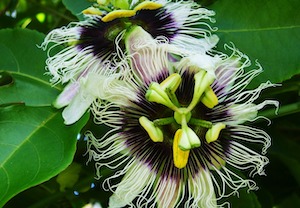Welcome to
Pro-Organic Belize
Tropical
Garden Grow Guide
Where you are the student and the teacher.


| Botanic Name |
passaflora
edulis |
| Plant Type |
perenial
fruit producing vine |
| Sun |
Prefers
full sun to partial shade |
| pH |
6.0-7.0 |
| Soil Preference |
Rich
organic soil with lots of compost and mulch to
protect and prevent the shallow roots from
wilting
|
Plant of
the month October 2024
Passionfruit
by Mary Loan
Overview about the plant: The passionfruit
plant is native to South America and grows widely in
tropical climates as far
north as southern Florida. The
flowers
of the plant are exquisite and ornamental; they
produce two main fruit
varieties, purple and yellow, that grow profusely on
the woody stemmed vines. The ovoid
fruits, about 1 1/2
to 2 inches in diameter contain rich,
sweet/sour multi-seeded jelled fruits
which are encased in tough outer shells.
The yellow variety is larger than the purple. Both
contain small amounts of delicious fruit
in each berry.
Purple passionfruit is
less acidic with a richer aroma and flavor.
Another name for passionfruit is granadilla,
a common variety.
How to grow: Plants may be
started from seeds or cuttings. Seeds
germinate within 2 to 3 weeks after
they are sown.
Plants may also be
started from cuttings of the mature wood of the
vine. Plant
each vine about 2-3 feet apart. It can
take up to 18 months to 2 years for a newly planted
vine to produce.
A trellis or sturdy fence is required to grow
passionfruit as the fruit bearing vines can grow to
be up to 30 feet in
length. Plants
do not grow well in
waterlogged soil, but must be kept evenly watered,
especially in the dry
season. Honey
bees and 'drunken baymen'
bees (Xylocopa sonorina) are the primary
pollinators of passion
flowers. In
the event of a lack of bees,
flowers may be pollinated by hand. There
is a plethora of information on the internet about
how and when to hand
pollinate the flowers.
Charles Boning,
author of 'Florida's Best Fruiting Plants', states
that purple passion
fruit is self-pollinating. He recommends that hand
pollination is sometimes
practiced to increase the fruit set.
Fruits mature between 2 and 3 months after
bloom. Vigorous
pruning post harvest is recommended
to increase fruit production and prevent your
passionfruit vines from becoming
a mass of tangled foliage,
Disease and insect control: Unfortunately
passionfruit is susceptible to many plant pests and
diseases. For some viruses
bacteria and fungus there is no cure.
Infected plants must pulled up and destroyed,
not composted.
Squirrels are fond of passionfruit and
love to share the harvest.
To harvest: The fruits
are
ripe to pick when the rind starts to pucker.
When in doubt, pick a fruit and hold it
between the palms of both hands
and squish firmly.
If ripe, the fruit
will ooze out ready for a sample taste which may be
a messy one.
Health benefits: Passionfruits are a
rich source of vitamin A and C. They
contain antioxidants, fiber, calciom iron and
potassium.
Recipes: Fruits are enjoyed
'out of hand' by cutting open the fruit and scooping
the delicious fleshy
pulp. Passionfruit
can also be made into
juice and many creative drinks with the addition of
complementary fruits.